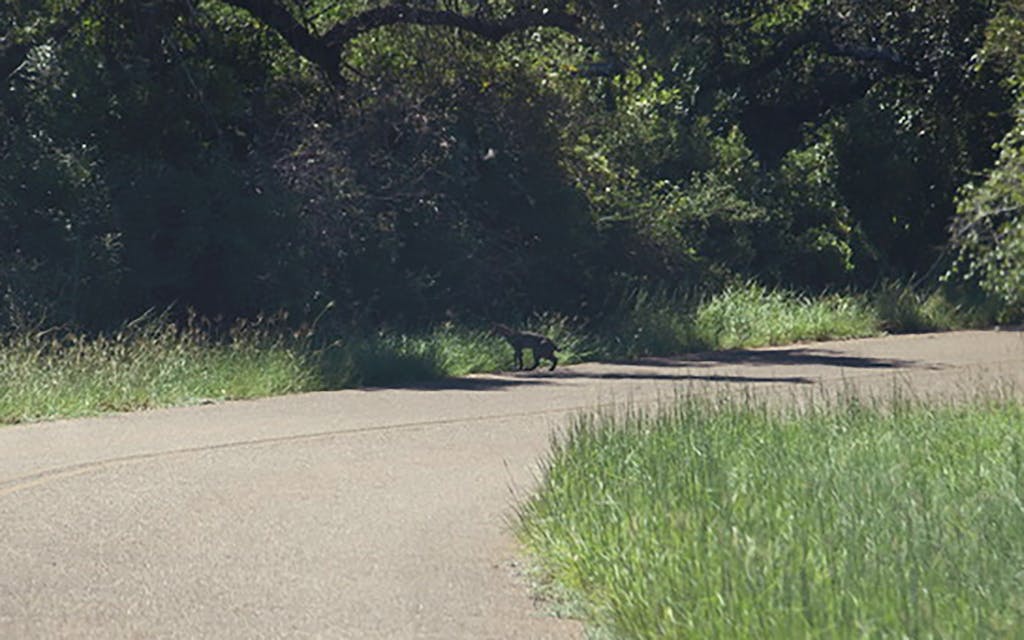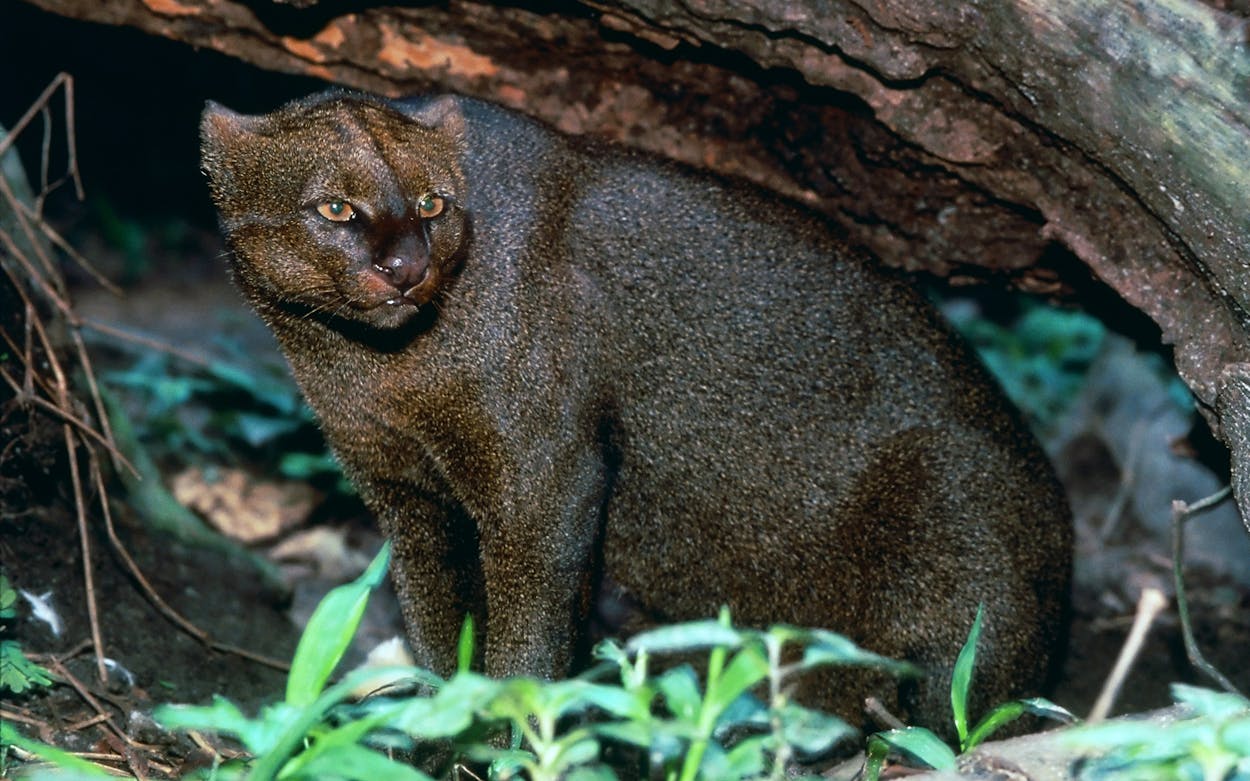Jim Schroeder rounded a bend in the Aransas National Wildlife Refuge this September, the side of his pickup brushing past high grasses emerging from the dense South Texas thickets. Schroeder’s sister, Linda, and her husband, Bob Carroll, who were visiting from Idaho, sat in the truck beside him. They had come to this stretch of the vast 115,000-acre refuge, near Austwell, to look for alligators, so the group drove slowly, eyes scanning the coastal landscape.
Then, as they came around the turn, they saw it: a striking black cat that appeared to have an elongated neck, a strange, narrow head, and a long tail. The creature stopped, looked at them, and paused for a moment.
“What the heck is that thing?” Schroeder said, bringing the truck to a halt. Carroll tossed him a camera, and Schroeder quickly snapped a couple photos through the windshield. Just then, the cat leaped away into the brush, gone in a flash.
Schroeder checked the photos. Had they all imagined the unusual sighting? But there it was—a black cat diving into the bushes. He sent the photos to the rangers at the refuge, convinced he had witnessed something rare and unusual. A ranger named Laura Bonneau emailed him back, polite but dismissive.
“She said, ‘Well, that’s a bobcat,’ ” Schroeder said. “But I sure don’t think so.”
“We would swear in front of anyone that it was a jaguarundi,” Carroll added.
The jaguarundi is a sometimes red, usually gray, cat with a lanky body, stubby legs, a long tail, and a thin, weasellike face. Shy and furtive, it’s easily confused with a house cat and is only slightly larger, topping out around sixteen pounds. Jaguarundis eat rodents, lizards, and birds. They can chirp, whistle, and chatter. The species is native to the jungles of Central America, with a range extending all the way from northern Mexico to central Argentina. Globally, it’s not threatened.
But that’s about the extent of what scientists know about the jaguarundi. The cat’s elusive nature makes it hard to study, and it doesn’t attract the same level of attention and funding as its more charismatic cousins, such as the ocelot or the jaguar. The few jaguarundi studies that have been done tend to focus on Central America; very little is known about the species’ history in Texas. One of the rarest, least-understood animals in the state, the jaguarundi has become a litmus test for your opinion on the reliability of citizen sightings and the sometimes blurred line between science and cryptozoology—the study of animals that might not exist.
In Texas, the jaguarundi is listed as endangered, but the Texas Parks and Wildlife Department has confirmed only five sightings in the history of the state. The most recent one was in 1986, when a roadkill corpse was spotted alongside a Brownsville highway. More than three decades later, most experts are convinced that the cat simply no longer exists in Texas. It’s a similar story in Arizona, where a 2009 study “found no recent evidence of a resident, reproducing population.”
“To me it’s more of a public, psychological, or sociological phenomenon than it is about the status of the animal,” said Jonah Evans, the leader of Texas Parks and Wildlife’s Nongame and Rare Species Program.
Evans, formerly the state mammalogist, originally operated under the assumption that jaguarundis were abundant in South Texas prior to the 1920s, when humans began encroaching on their habitat and clearing the thick, thorny scrub the cats call home. But the more he dug into the evidence (or lack thereof), the more Evans became convinced that Texas had never been a significant part of the jaguarundi’s range.
Unlike the ocelot, another rare Texas cat, which has had confirmed sightings in wide swaths of the state, the jaguarundi just doesn’t have a historical record in the Lone Star State. There are thousands of trail cameras all over Texas. According to Evans, state agencies and academic researchers have conducted massive trail and camera studies looking for ocelots in the Rio Grande Valley, all throughout what should be prime jaguarundi habitat. None of these efforts has ever caught the creature on camera.
Still, every year, Evans receives dozens of reports from people claiming to have seen a jaguarundi. He’s not the only one. Reports abound on social media, and Pat Bumstead, the director for the Canada-based International Society for Endangered Cats, hears about Texas sightings on a near-monthly basis. Most folks remain entirely convinced that what they’ve seen is a jaguarundi.

“You would not believe the pictures we receive,” Bumstead said. “It’s a fox; it’s a squirrel going up a tree! Frankly, I hope we find one, and then we can go looking for a yeti, or the Abominable Snowman.”
Many sightings that cross Bumstead’s desk involve animals that don’t fit the characteristics of a jaguarundi or come from regions where the cat’s presence is highly unlikely. But there are some reports that strike her as more credible. These, Bumstead says, come from park rangers with backgrounds in biology, and include highly detailed descriptions that match that of a jaguarundi. Others are from ranchers who have worked their land their whole lives and know what lives on it. Jaguarundis have been spotted in the Sierra de San Carlos mountain range in northern Mexico, and individuals can range more than twenty miles. Is it really so unlikely that some have crossed into Texas?
Michael Tewes, an expert in wild cat studies at Texas A&M’s Caesar Kleberg Wildlife Research Institute in Kingsville, thinks it is. That mountain range is one hundred miles deep into Mexico, and most of the land between there and Texas has been cleared for agriculture. It’s theoretically possible a jaguarundi may have made it over the border into South Texas, but it’s a stretch.
As for sightings elsewhere in the state: “In the recorded history of humans, there has never been a single jaguarundi found north of the Rio Grande Valley,” Tewes said.
So how to reconcile the rash of reports with scientists’ confidence that there are no jaguarundis in Texas? The answer hinges, in large part, on researchers’ dogged conviction that citizen sightings are the least reliable form of evidence. Memories of an animal can become warped once people start looking up photos online, and two very common species, the house cat and the bobcat, are both easily mistaken for a jaguarundi. Most significantly, the sightings are usually not documented, not repeatable, and not verifiable. There are plenty of websites with comprehensive reports of Bigfoot sightings too—but it doesn’t mean we’re any closer to finding one. Rather than contributing to a broader understanding of the jaguarundi, sightings instead become a kind of folklore.
But there are a few scientist-advocates who remain open to the possibility of jaguarundis in Texas, in large part because of reports from the public. The two researchers in this camp who spoke with Texas Monthly both work for wildlife nonprofits.
“This whole idea [that jaguarundis don’t exist in Texas] is based on completely flawed reasoning,” said Anthony Giordano, president of the Society for the Preservation of Endangered Carnivores and their International Ecological Study (S.P.E.C.I.E.S.). “ ‘If they were here we would know’—no!”
Giordano has conducted field studies in the Big Bend region that were unique in their willingness to consider the plausibility of citizen sightings. Ultimately, Giordano’s approach is to take the public seriously. If lots of people say they’ve seen something, he argues, maybe they have. Other areas of wildlife biology, such as ornithology, have a long tradition of utilizing public sightings to determine a species’ range. TPWD staff often talk to hunters to get an idea of the kind of wildlife they’re seeing. And camera traps, Giordano argues, aren’t enough. Even in areas of South America where jaguarundis are more abundant, he says he rarely catches them on camera.
The U.S. Fish and Wildlife Service took the viability of South Texas as jaguarundi habitat seriously enough to produce a recovery plan in 2013, although, according to Evans and Tewes, it has seen little to no progress over the past eight years.
Michael Robinson, a senior conservation advocate for the Center for Biological Diversity, believes it’s a mistake to declare Texas inconsequential for the jaguarundi’s survival. When habitats are fragmented, individual populations are disconnected from one another and become vulnerable. Even widespread species can diminish quickly. Bighorn sheep, for example, were once widely distributed across the western United States. But as competition with livestock, hunting, and development broke up their range, their populations dwindled rapidly.
“Just because [Texas] is at the periphery doesn’t mean it’s not prime habitat,” Robinson said. “I don’t think we should write them off that quickly.”
Whether or not there are jaguarundis out there, lurking somewhere in the thorny scrub brush, ultimately won’t change the course of history. But to the people who believe they’ve seen them, the experience is meaningful. As a discipline, science requires a healthy skepticism. Folklore allows us to believe that the world might be a little bigger than we know, and that a day trip to a wildlife refuge can become something strange and beautiful.
“I admit that there might be a romantic element for me,” Giordano said. “But at one point in time, every scientist was a cryptozoologist.”
Evans, the TPWD rare-species expert, still isn’t a believer, though he adds, “I’d be the happiest person in the world to be proven wrong on this.”
- More About:
- Critters
- Wildlife
- Port Aransas






